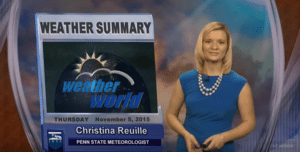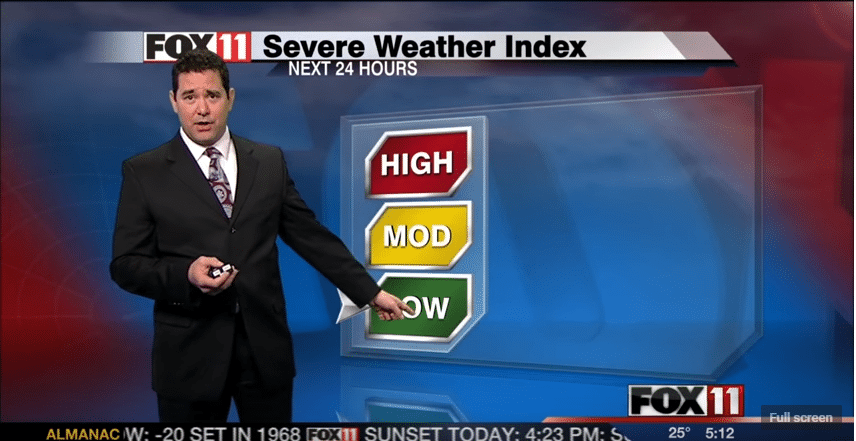Earlier this month, the American Press Institute presented an idea that we believe could help with two challenges confronting journalism: a continuing decline in trust by much of the public, and a lack of understanding about media and its functions.
We believe that if stories are built differently — using forms that follow a philosophy of “show me” rather than “tell me” with their audiences — journalists could build news consumers’ confidence in media and media savvy at the same time.
We came up with a name for this process/design: organic news fluency. We also wanted to find a good example that incorporated the questions, answers and presentation we’d like to see in every type of story.
But there have been examples of this for years, including one that many television viewers are familiar with — in the first 15 minutes of your local news broadcast.
Meteorologists and weather reporters have understood for years, decades even, how to engage their audiences with a topic that can be full of science jargon and fraught with uncertainty.
“The trick is…to approach the weather as if you’re telling a story: Who are the main actors? Where is the conflict? What happens next?” Bob Henson, a meteorologist for the online forecasting service Weather Underground, said in a recent Mental Floss interview.
“Along the way, you have the opportunity to do a bit of teaching. Weathercasters are often the only scientists that a member of the public will encounter on a regular basis on TV.”
Good journalism plus an “organic” opportunity to improve audience skills or news fluency is exactly what we’re after. How can journalists do that? By answering a few important questions in a way that’s front-and-center — not hidden within a long story or somewhere else on a website. Those questions might include:
- What’s new here? What have we already reported?
- What do we know now?
- What evidence is there? Who are the sources?
- What are the credentials of this journalist?
- What facts don’t we know yet? What’s in dispute?
- What might happen next? What could change?
- How and when will it be covered?
- How can people respond or get involved?
Take a look at how these questions align with a daily forecast from your average local TV newsroom:
John Elliott, a meteorologist with CBS2 in New York, explains what will happen with your weather and reminds you what already has happened. Using visual elements like radar maps and chyrons, he demonstrates how air masses affected the region’s snowfall. He explains how this involves you: Your commute will be a mess tomorrow.
If you watch Elliott’s full forecast, you learn there’s another way to get involved: their Weather Watchers program, which is mentioned at the top of the broadcast along with overlays of viewers’ snow photos.
At WLUK-TV, the Fox affiliate in Green Bay, Wis., meteorologist Patrick Powell explains what’s behind a new round of snow and cold temperatures. But he’s careful to stick to what’s likely to happen “at least in the next 24 hours.” (Meteorologists are well aware of the old jokes about having a job where you can be so wrong, so often, without being fired.)
And if people want to know what qualifies Powell to deliver the forecast to them in the first place, it’s all right here in his online bio: his awards, degrees and certifications; his years as a stormchaser; his position with the American Meteorological Society.
Weather reporters and meteorologists often are highly engaged with people online, continuing the conversation and opportunities for weather fluency. The Capital Weather Gang* at The Washington Post often produces “explainers” like this one on weather models and uses them for context in future weather forecasts:
What exactly are weather models and how do they work? https://t.co/8TSBfadnuN
— Capital Weather Gang (@capitalweather) May 18, 2018
At WEWS-TV, the ABC affiliate in Cleveland, Ohio, meteorologist JD Rudd offers a visual perspective on a hurricane that’s almost too big to fathom:
Hurricane #Irma now a category 5 and it’s a beast. It’s larger than the state of Ohio, if that helps put it in perspective. pic.twitter.com/JtoZNlONeE
— ⚡JD Rudd – News5 ☈ (@jdrudd) September 5, 2017
Weather reporters also tend to dive into a place that many journalists are reluctant to go — fake news on social media. Especially during weather crises, they spend an increasing amount of time trying to correct misinformation and flat-out fakery from troublemaking tweeters. (Marshall Shepherd of the University of Georgia calls them “social mediarologists.”)
Already starting to see very IRRESPONSIBLE stuff like this, please beware of social mediarologist crap…follow credible sources pic.twitter.com/2pgueP7ANU
— Marshall Shepherd (@DrShepherd2013) January 3, 2017
YES YES YES! The guy that posted this is from #Dublin. Just killing us. At last check, it had been shared over 3K times. https://t.co/Nvj3P6zAVe
— Jeff Cox (@JeffCoxWGXA) January 3, 2017
This kind of engagement requires knowing and understanding their audience – something many weather reporters have been doing naturally for years. Back in 1994, the Weather Channel did a deep survey of their audiences and came up with a typology — the kind of research that many other news organizations only recently have started to examine.
Weather Channel co-founder Frank Batten* wrote in his 2002 book that company officials wanted to analyze “how consumers of weather information feel about that information, and how they use it.” The Weather Channel segmented their audience into three kinds of consumers:
Weather Commodity – seek out weather infrequently and mainly for local forecasts
Weather Planner – heavy viewers of weather information who use it to plan work and recreational activities
Weather Engaged – also heavy viewers, but profoundly passionate and curious about how weather works.
Watch your local weather forecast and you’ll likely see how the weather report informs, in some way, each one of those audiences. This kind of segmentation and interest level can be applied to other news topics: education, sports, business, entertainment.

- They discuss what’s happening right now, what happened yesterday, and various scenarios for the future.
- They use highly attractive visuals to make complex data easier to comprehend.
- They attribute their information to weather sources and models.
- They provide context: both historic and geographic.
- They offer information for each type of weather consumer.
- They engage with audiences by providing more information through social media and fighting misinformation.
- They display their credentials.
- They build, recycle and update “explainers,” adding depth to their reports.
And we think those actions can lead to a more informed, more fluent consumer.
Let us know if you’re giving it a try.
*Disclosures: The Capital Weather Gang was part of my team when I was an editor at The Washington Post. And I worked for Frank Batten when he was publisher of the Landmark-owned Virginian-Pilot.
You might also be interested in:
The two organizations will provide a series of monthly webinars to local media leaders and journalists in the months leading up to the 2024 U.S. elections, and share practical resources throughout the year to support news organizations’ evolving needs around local elections and democracy.
We challenge local news organizations to smartly deploy their resources around the elections that most matter to their communities in 2024 — and also to think about how that energy builds to something more robust and sustained.
Journalism has the power to connect our communities, to bring out the best in what our society can be. Our goal is to help us all get there.



